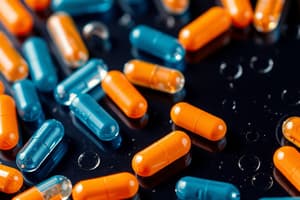Podcast
Questions and Answers
What is the mechanism of action of A1-adrenergic blockers?
What is the mechanism of action of A1-adrenergic blockers?
- Inhibit type 1 beta-adrenergic receptors
- Decrease HDL cholesterol
- Inhibit smooth muscle contraction (correct)
- Increase heart rate
Which adverse effect is specifically associated with the first dose of prazosin?
Which adverse effect is specifically associated with the first dose of prazosin?
- Insomnia
- Nausea
- Sexual dysfunction
- Postural hypotension (correct)
What is the primary mechanism of action of beta-adrenergic blockers?
What is the primary mechanism of action of beta-adrenergic blockers?
- Promote smooth muscle contraction
- Increase heart rate
- Block the effects of adrenaline (correct)
- Increase blood pressure
Which population should beta-adrenergic blockers be used with caution in?
Which population should beta-adrenergic blockers be used with caution in?
What is a common adverse effect of combined alpha- and beta-adrenergic blockers?
What is a common adverse effect of combined alpha- and beta-adrenergic blockers?
What do peripheral adrenergic antagonists target in the nervous system?
What do peripheral adrenergic antagonists target in the nervous system?
Which adverse effect is commonly associated with peripheral adrenergic antagonists?
Which adverse effect is commonly associated with peripheral adrenergic antagonists?
Why should alpha- and beta-adrenergic blockers not be used in patients with sick sinus syndrome?
Why should alpha- and beta-adrenergic blockers not be used in patients with sick sinus syndrome?
'They make your heartbeat slower and relax the blood vessels' refers to which class of medication?
'They make your heartbeat slower and relax the blood vessels' refers to which class of medication?
Flashcards
Penicillin G
Penicillin G
A natural penicillin, administered via IM, often combined with Probenecid to delay excretion. Used for syphilis and gram-positive infections.
Amoxicillin
Amoxicillin
An aminopenicillin with an extended effect, often taken orally and combined with Clavulanate. Used in triple therapy for H. pylori GI infections.
Methicillin
Methicillin
A penicillinase-resistant penicillin, previously used in the US to treat infections caused by penicillinase-producing staphylococci, including MRSA.
Ticarcillin
Ticarcillin
Signup and view all the flashcards
Piperacillin
Piperacillin
Signup and view all the flashcards
Cefazolin
Cefazolin
Signup and view all the flashcards
Carbapenems
Carbapenems
Signup and view all the flashcards
Imipenem
Imipenem
Signup and view all the flashcards
Aztreonam
Aztreonam
Signup and view all the flashcards
Vancomycin
Vancomycin
Signup and view all the flashcards
Methotrexate
Methotrexate
Signup and view all the flashcards
6-Mercaptopurine
6-Mercaptopurine
Signup and view all the flashcards
5-Fluorouracil
5-Fluorouracil
Signup and view all the flashcards
Indomethacin
Indomethacin
Signup and view all the flashcards
Ibuprofen
Ibuprofen
Signup and view all the flashcards
Docusate
Docusate
Signup and view all the flashcards
Glycerin
Glycerin
Signup and view all the flashcards
Alpha-1 Adrenergic Blockers
Alpha-1 Adrenergic Blockers
Signup and view all the flashcards
Beta-Adrenergic Blockers
Beta-Adrenergic Blockers
Signup and view all the flashcards
Study Notes
Penicillins
- Natural Penicillins: Benzyl Penicillin (Penicillin G)
- ROA: IM, combined with Probenecid to prevent early excretion
- Indications: Syphilis, treatment of infections caused by gram-positive agents
- Aminopenicillins: Amoxicillin
- Extended effect due to amino group
- ROA: Oral, combined with Clavulanic Acid (Co-Amoxiclav)
- Indications: Part of triple therapy for H. pylori GI Infection
- Penicillinase Resistant: Methicillin
- Not used clinically in the US due to cases of interstitial nephritis
- Indications: Treatment of infections caused by penicillinase-producing staphylococci, including MRSA
- Antipseudomonal Penicillins:
- Carboxypenicillin: Ticarcillin
- Ureidopenicillin: Piperacillin
- ROA: IV, combined with Tazobactam (Piptaz, Tazocin)
- Indications: Skin infections, UTI, Bacterial sepsis
- ADR: Hypersensitivity (5%), Diarrhea, Nephritis
Cephalosporins
- 1st Generation: Cefazolin, Cephalexin
- 2nd Generation: Cefuroxime, Cefaclor
- 3rd Generation: Cefdinir, Cefotaxime, Ceftriaxone
- 4th Generation: Cefepime
- MOA: Beta-lactam rings bind to the penicillin-binding protein and inhibit its physiological activity
- Indications: Syphilis, Uncomplicated Gonorrhea, potentially indicated in treating Lyme disease caused by B. burgdorferi
- ROA: IV, IM
- ADR: Acute renal failure, Gl upset, Pain at injection site
Carbapenems
- Thienamycin: First carbapenem produced from S. cattleya
- Imipenem: Easily degraded dehydropeptidase, usually combined with Cilastatin (DHP inhibitor)
- Contraindicated in epileptic patients
- Meropenem: Not easily degraded by DHP, greater potency in gram-negative and anaerobic bacteria
Monobactams
- Aztreonam: Effective against gram-negative bacteria
Polypeptides
- Vancomycin
- MOA: Inhibits cell wall synthesis by binding firmly to the D-Ala-D-Ala terminus, preventing further growth and cross-linking
- Indications: MRSA, Epidermidis, Colitis
- Other Polypeptides: Not listed
Antimetabolites
- Methotrexate
- MOA: Dihydrofolate reductase (DHFR) inhibitor
- Indications: Breast cancer, Head & Neck cancer, Bladder cancer, Non-Hodgkin's lymphoma
- ADR: Mucositis, Diarrhea
- 6-Mercaptopurine
- MOA: Inhibits de novo purine synthesis
- Indications: Acute myelogenous leukemia
- ADR: Nausea, Myelosuppression, Immunosuppression, Hepatotoxicity
- 5-Fluorouracil
- MOA: Inhibits thymidylate synthase and its metabolites
- Indications: Gl cancers, Breast cancer, Hepatocellular cancer
- ADR: Nausea, Mucositis, Diarrhea, Hepatotoxicity
NSAIDs
- Indomethacin: Must be taken with food, highly irritating
- Indications: Rheumatoid arthritis, OA, Gout
- ADR: Edema
- Sulindac: Prodrug → converted to its active sulfide form
- Diclofenac Sodium (Voltaren): Analgesic, often used after ophthalmic surgery, minimal to no antipyretic effects
- Propionic Acid Derivatives: Ibuprofen
- Fenamates: Mefenamic acid
- ADR: Flatulence, impaction, excessive bowel activity
- Contraindications: Hypersensitivity, bowel obstruction, symptoms of appendicitis or acute surgical abdomen, GI ulceration/adhesions, fecal impaction, dysphagia, rectal bleeding
Laxatives
- Stool Softeners or Wetting Agents: Docusate
- MOA: Increases the amount of water the stool absorbs in the gut, making the stool softer and easier to pass
- ADR: Stomach pain, diarrhea or cramping
- Contraindications: Intestinal obstruction, symptoms of appendicitis or acute abdominal pain, fecal impaction; concomitant use of mineral oil; nausea or vomiting
- Saline Laxatives or Enemas: Glycerin
- MOA: Hygroscopic and/or local irritant action, drawing water from the tissues into the feces and reflexively stimulating evacuation
- ADR: Hypersensitivity
- ROA: Rectally
- Contraindications: Acute abdominal pain, N/V, symptoms of appendicitis or undiagnosed abdominal pain
- Lubricant Laxatives: Castor oil
- MOA: Ricinoleic acid acts as an anionic surfactant that reduces net absorption of fluid and electrolytes and stimulates intestinal peristalsis
- ADR: Stomach/abdominal pain or cramping, nausea, diarrhea, or weakness
- Contraindications: Hypersensitivity, GI obstruction or perforation, severe impaction, symptoms of appendicitis or acute surgical abdomen, ulcerative colitis, rectal fissures
Adrenergic Blockers
- Alpha-1 Adrenergic Blockers: -zosin
- MOA: Bind to and inhibit type 1 alpha-adrenergic receptors and thus inhibit smooth muscle contraction
- ADR: Postural hypotension, weakness, palpitations, dizziness
- Precautions: Use cautiously in older adult patients because of hypotension
- Beta Adrenergic Blockers: -olol
- MOA: Block the effects of the hormone adrenaline, making the heartbeat slower and relaxing the blood vessels, which reduces blood pressure
- ADR: Bradycardia, insomnia, fatigue, sexual dysfunction, bizarre dreams, decreased HDL cholesterol
- Precautions: Not for use in patients with asthma, COPD, CHF, heart block, and sick sinus syndrome. Use with caution in patients with diabetes and peripheral vascular disease
- Combined Alpha- and Beta- Adrenergic Blockers
- MOA: Combined MOA of Alpha-Adrenergic Blocker and Beta-Adrenergic Blocker
- ADR: Nausea, fatigue, dizziness, asthma, headache
- Precautions: Not for use in sick sinus syndrome or heart block; used in caution in CHF, bronchial asthma, COPD, and diabetes mellitus
- Peripheral Adrenergic Antagonists
- MOA: Target the presynaptic adrenergic neurons in the peripheral nervous system and prevent them from effectively releasing the catecholamines norepinephrine and epinephrine
- ADR: Sexual dysfunction, nasal congestion, postural hypotension, diarrhea, lethargy
- Precautions: Use very cautiously in older adult patients because of hypotension
Studying That Suits You
Use AI to generate personalized quizzes and flashcards to suit your learning preferences.



